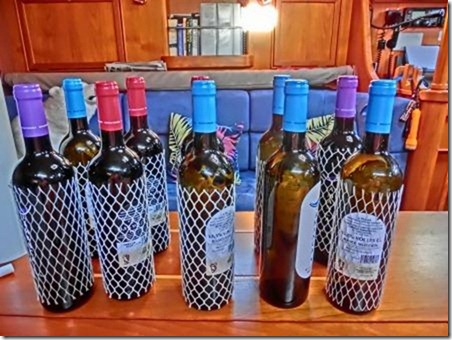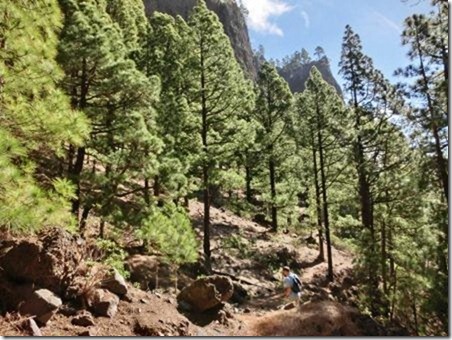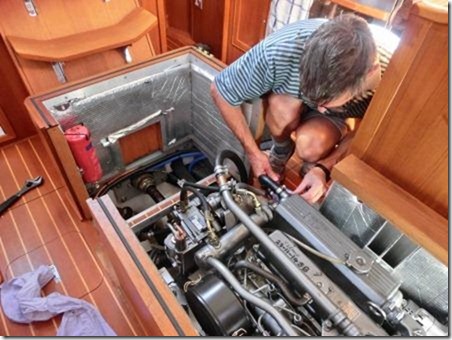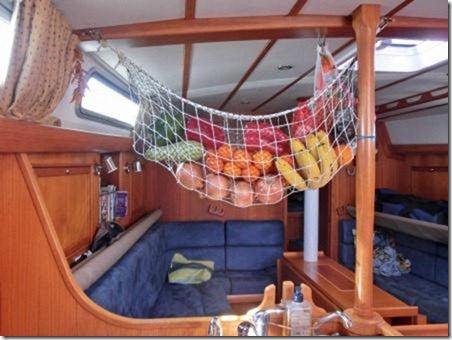Photographs from La Palma

Awelina of Sweden
James Collier
Tue 26 Jan 2016 10:40
|
28:38.46 N, 017:56.63 W
As promised, here are photographs of the island of La Palma. Of all the
islands in the Canaries, it's probably the most scenic. In fact it's called 'La
Isla Bonita' (even Madonna sang about it apparently).
  W side of La Palma from the sea, and the mooning statue on the massive
breakwater at Tazacorte.
From Tazacorte there’s a climb up what looks like a vertical cliff, 600m
up, to the mirador of mount El Time.
  View after a hot but exhilarating climb. James tried running back down (at
least part of it). One could just see the marina: spot Awelina.
We then hired a car and drove across the island, first to the capital Santa
Cruz.
  Which is really quiet and unspoilt with cobbled streets and old houses with
traditional balconies still very much in evidence.
We then drove on, across the middle / north if the island, on a twisty and
climbing road, reaching all the way to about 2400m.
 View of Gomera from about 2000m. The vegetation has just changed, having
gone from cacti to pines to deciduous woods and then to gorse and scrub.
 The Infinity Monument. The finger boards, instead of pointing to London -
4032 miles or New York - 2786 miles etc point obliquely, and say ‘Polaris – 346
light years’.
A bit further on is the astrophysics complex which is what we went up to
see.
  The gamma-ray telescopes in the foreground and the famous Herschel
telescope with its 4.2m lens seen from the SSW. Above the clouds – a long way
above!
 But behind the ridge to the S it’s a different story with boiling clouds
looking like surf on a beach. Mount Teide on Tenerife is just visible in the
background.
We then drove on down to the northwest side of the island, where the
vegetation changes again to almond blossom and vineyards, although still at
around 800m.
  We began to see wine growers advertising. So we stopped at one, Vega Norte
and then had to find stowage aboard! They told us proudly that they’d just done
a deal with Naked Wines for ‘Vega Norte Blanco’. Don’t know if it travels, but
it’s jolly good here!
Apart from the observatories, the other thing that la Palma is famous for
is the possibility of an enormous volcanic eruption which will create a tsunami
that will destroy half the American eastern seaboard. We went to the rim of the
caldera. You have to get a special permit to drive there, so instead we parked
at the bottom and took a taxi up. This proved a good decision as we then could
walk back down.
  The start of the path down, near the rim. It’s 6 or 7 km and descends 500m
or so, through pines and then upland farmland
 ending in the valley floor at the Ermita Virgen del Pino, from where a kind
couple form Germany gave us a lift back to our car (which was parked a few km
away).
In the northeast of the island there is a famous gorge called Los Tilos,
which just means ‘the laurels’ but is a UNESCO biodiversity site. We walked on a
marked trail a km or two to the head of the trail, which is at a
waterfall.
  But if you don’t mind getting a tiny bit wet you can walk through the
waterfall and into a deserted river bed,
 which goes on for miles. However you’re not supposed to go off the marked
trails, and this one was definitely unmarked, so we turned back after an hour of
so. Also we discovered a very active hornets nest right in the middle of the
river bed, which rather put us off going further!
 View from above of the gorge we’d been exploring.
After these touristic excitements we also had to do some boat work.
  Servicing the engine as it’s done 250 hours since leaving Falmouth, and
adding a cockpit shower hose,
 which is being tested here. A great success, many thanks to Andy Holmes for
his help at B&Q.
Then stocking the boat in preparation for setting off towards Cape Verde,
800 miles to the SSW.
  Trolley outside SuperDino, and some of its contents back aboard Awelina,
hanging in the new hammock constructed by Fiona.
|